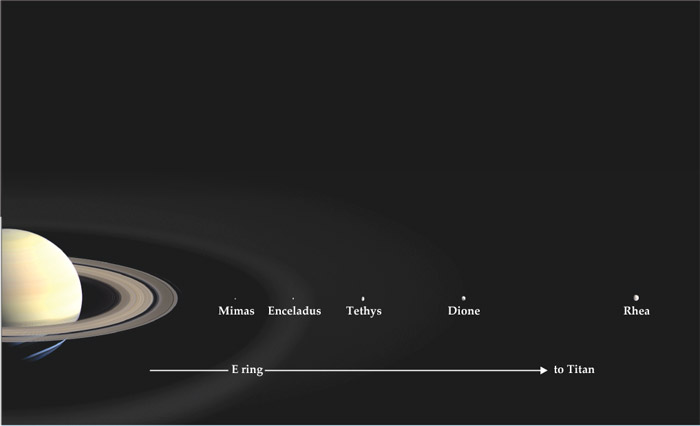|
|

|
 |
|
 |
|
|
 |
|
 |
 |
|
 |
|
Enceladus, discovered in 1789 by William Herschel, has intrigued astronomers since the 1980s.1 For nearly 200 years it had been an undistinguished member of the Saturn system, one of five medium-sized satellites circling the planet between the outer edge of the main ring system and the orbit of Saturn’s giant moon Titan (see figure 1). The first hint that something exceptional was happening there came in early 1980 when scientists using Earth-based telescopes acquired new images of a faint outer ring of Saturn—the E ring—which had been discovered in the 1960s. Those images revealed that the ring’s brightness peaked at the orbit of Enceladus. They also showed that unlike Saturn’s other rings, the E ring scattered sunlight more efficiently at shorter wavelengths, which indicated that the ring was dominated by particles not much larger than the wavelength of light. Sputtering by charged particles in Saturn’s magnetosphere would erode away such micron-sized particles on time scales of decades to hundreds of years, so something had to be replenishing the ring on comparable time scales. The peak in ring density at Enceladus pointed to that moon as the likely source.

Fig 1.
Figure 1. Enceladus and the four other midsize moons of the inner Saturn system are depicted in this artist’s conception, drawn to scale (though moon sizes are exaggerated for clarity). The diffuse E ring exhibits a spike in density at the orbit of Enceladus.
Shortly thereafter the Voyager 1 and Voyager 2 spacecraft returned the first detailed images of Enceladus and the other major Saturnian moons. The surfaces of most of the moons appeared ancient, dominated by impact craters formed early in the solar system’s history. But Enceladus looked very different. Much of its surface was almost crater free; instead, it was covered by tectonic fractures that evidently had formed relatively recently. The Voyager images also revealed that Enceladus reflects about 80% of the sunlight it intercepts and thus has the highest albedo of any known solar-system object. Ground-based spectroscopy of 1- to 2.5-µm-wavelength sunlight reflected from the surface of Enceladus and its neighboring moons showed the characteristic molecular vibration absorption bands of water ice, but the impurities that darkened the ice on the other moons appeared to be almost absent on Enceladus. Some scientists speculated that a tidal heat source inside Enceladus was generating the observed tectonic activity that perhaps included geyser-like eruptions that could generate the E ring and coat the surface with clean ice.2
In the 1990s the Hubble Space Telescope’s observation of 0.309-µm emission revealed a different kind of ring—a Saturn-circling torus of OH molecules. Like the collocated E ring, the OH torus seemed to require a continuous source of material in the vicinity of Enceladus.3

Figure 2. Tiger stripes. (a) This false-color Cassini mosaic of Enceladus displays a variety of landforms. The upper-right part of the 500-km-diameter disk shows some of the moon’s older, cratered terrain, whereas the upper left shows tectonically disrupted terrain of intermediate age. The lower part of the disk is occupied by the young south polar terrain; the red dot indicates the south pole. The four parallel bluish fractures surrounding the south pole are the active tiger stripes, source of Enceladus’s plumes. The blue color in the image arises because coarse-grained water ice absorbs the near-IR wavelength used, in part, to generate the mosaic images. The area bounded by the red rectangle is magnified in (b), a view of one of the most active parts of the tiger stripe Damascus Sulcus.
See the website for more details:
http://physicstoday.org/resource/1/phtoad/v64/i11/p38_s1?bypassSSO=1#figref_f1 (SY) |
|
|
|
 |
|
 |
|
|
Copyright? Purple Mountain Observatory, CAS, No.10 Yuanhua Road, Qixia District, Nanjing 210023, China
Phone: 0086 25 8333 2000 Fax: 8333 2091 http://english.pmo.cas.cn |
|
|
